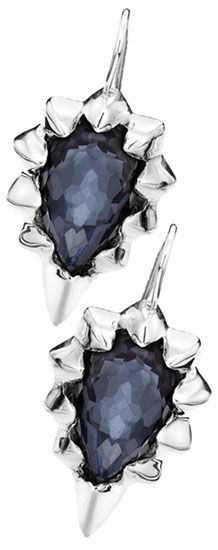|
Colored Gemstone
Double Vision
Backing translucent pastel gemstones with hematite or mother-of-pearl to create doublets adds new colors and texture to gems.
By Sheryl Jones
 |
| Margo Manhattan |
Velvety purple amethyst, sunny lemon quartz, mint green prasiolite, blue topaz and rhodolite are just a few gemstones that are being transformed into spectacular shades of color after being fused together with other material such as hematite or mother-of-pearl to form doublets. These innovative combinations are giving well-known gemstones new depth and luster — making a technique that was best known for creating beautiful and durable opals popular again.
In addition to creating new colors with natural gemstones, doublets are a way to use natural gemstone material that is sometimes too fragile to be set and worn alone. This is the case with most opals, which are the most common and popular doublet. Opal deposits form in thin layers, making the stone so fragile that it is often too delicate to wear. By fusing this material on top of a less expensive natural or man-made material, the opal becomes more durable.
Peter Blythe, of Mineshaft, based in Canberra, Australia, and a self-professed “opalholic,” says he cuts his opal into free-form shapes and fuses it to either potch opal, which is opal without color or play, or ironstone, which is the less desirable product that remains after cutting a boulder opal. The result of fusing opal on top of dark material is a vivid, dazzling array of colors that looks amazing and sell quickly.
Doublets also make gemstones that are more expensive due to lack of availability more affordable. “I have seen an increase in the popularity of opal doublets within the past five years due to the shortage and expense of solid black opal,” Blythe says. “Doublets are a good alternative for a fraction of the cost, but with the vivid colors and individuality only opals can provide. Solid black opal can range in price from $3,000 to $100,000, which is too expensive for most customers. But a high-quality doublet that ranges from $300 to $1,000 is much more affordable.”
Abeer Jain, director of marketing and sales at Fine Gems NY Inc., says he and his father, Amar Jain, president of the firm, have been manufacturing doublets for the past ten years. “As quality natural gemstone material becomes scarce and more expensive, this is a way to provide new products by maximizing the use of the same natural stones we always offer without using synthetics to create new colors,” says Abeer.
Abeer and his father improved the process of fusing the stones together using a proprietary process. “The technique involves creating a special adhesive to merge the stones that does not bubble or alter the natural composition or the color of the natural gemstones in any way,” explains Abeer. The results are beautiful, durable stones that have a more intense, rich color that looks seamless from the top.
Gemstones such as good-quality amethyst and prasiolite in very large sizes can be expensive. But making doublets requires less material and has the added benefit of giving a new look to more expensive gemstones. Amar adds, “The most popular product combinations have been amethyst backed with hematite, rose lavender amethyst backed with hematite, crystal with hematite, lemon quartz with hematite, moon quartz with mother-of-pearl, rose quartz with mother-of-pearl, crystal with mother-of-pearl.” The hematite adds sparkle and shimmer and the mother-of-pearl gives stones a luminescent quality. These attractive combinations, which can be set in all types of metal, offer customers more options and a way for jewelers to increase sales.
Other gemstone combinations the Jains manufacture include smoky quartz with mother-of-pearl, smoky quartz with black mother-of-pearl, citrine with mother-of-pearl, peridot with mother-of-pearl, blue topaz with mother-of-pearl, amethyst with black mother-of-pearl, lemon quartz with pink mother-of-pearl, prasiolite with hematite. The Jains are continually adding new creative combinations, such as crystal with rhodolite, peridot with mother-of-pearl and aquamarine with mother-of-pearl.
The Jains’ new line of doublets is a success with long-time customers, among them, jewelry designer, Margo Manhattan. Her eponymous line features the crystal and hematite and crystal and mother-of-pearl doublets. “I love the stones. The colors are deep and mesmerizing. They work perfectly with my edgy rock‘n’roll design esthetic,” says Manhattan.
With so many different varieties of gemstones to choose from, the potential combinations of gemstone doublets and resulting shades of color are endless. Selecting the right colors can be challenging. “My rule of thumb is if it is bright and colorful, it will sell quickly,” says Blythe. But he adds, “To make the most vibrant doublets requires high-quality material, which is getting harder to source.” Even so, doublets are still the best option of presenting natural gemstones in new colors. Doublets may provide the right competitive edge in a market where manufacturers and jewelry designers need to present new and exciting material at affordable prices.Article from the Rapaport Magazine - February 2016. To subscribe click here.
|
|